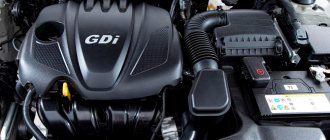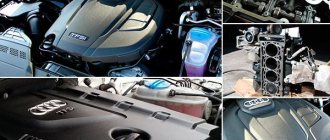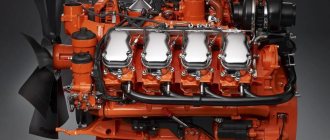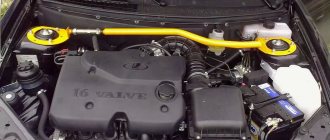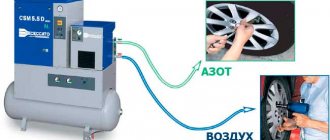As you know, cheaper gas fuel allows you to significantly save money during the operation of various vehicles. To do this, it is enough to install HBO on your car.
In the case of gasoline engines, gas equipment has been used since the days of carburetor engines. Further development of gas injection systems made it possible to install similar solutions on injection engines, both on engines with distributed injection and on engines with direct injection.
As for diesel engines, just a few years ago it was not possible to convert diesel engines to gas, or such work would have been very difficult. However, today the situation has changed radically. Next, we will talk about how to convert a diesel engine to gas, what gas-diesel is, as well as what pros and cons this solution has.
How does HBO work?
Diesel fuel burns under pressure, but gas does not. The process will proceed as follows:
- The supply of diesel, which is responsible for ignition, is reduced.
- The gas injection process takes place.
Gas injectors will work simultaneously with diesel ones. Their ratio depends on the engine speed. Most often it is 50/50 for propane. If methane, the gas share increases to 70 percent and higher. If you're driving on the highway, gas usage will be highest.
What fuel can a gas-diesel engine run on?
It is possible to convert an engine to a dual fuel system only for a specific type of gas. Either it will be methane
, or
a propane-butane mixture
. It is more expensive to make a methane-powered diesel engine, but it will work with better economic effect than the propane version. In addition, methane is cheaper. When supplying propane to a diesel engine, the contribution to the total fuel consumption will not exceed 30-50%. But the share of consumption of the methane component can be increased to 80%. It all depends on the operating mode of the internal combustion engine, which takes into account: • vehicle speed; • season (summer, winter); • load on the vehicle; • terrain (mountains, plain); • gas pressure and temperature; • turbocharged diesel or not.
HBO equipment
It has few differences when compared with gas equipment for gasoline engines. But on diesel engines it becomes possible to control the supply of diesel fuel using a special device.
For cars with different fuel supply systems, electronic activators or software units that control the system are suitable.
They allow you to shut off or open the gas system if necessary. Their advantages:
- Security system monitoring.
- Possibility of opening the gas supply if it runs out.
- The ability to force the car to use diesel by pressing just one button.
Methane
Methane is a natural gas that is stored in deposits deep within the earth. It is used almost in its pure form, only slightly filtered. Methane has the highest safety among gases, and it is almost completely environmentally friendly. This gas cannot be spoiled or diluted in any way. Its composition always remains the same.
Filling a car with methane is 3 times cheaper than filling a car with gasoline, which is a big advantage of this type of gas. If we consider the environmental friendliness of methane, it has a special standard - Euro 5. This indicates its high environmental friendliness. Methane is considered a modern fuel and is loved by motorists in many European countries, as well as in the USA, because by using it you can reduce the amount of harmful emissions several times.
Economic effect
The most important thing here is monetary interest. The higher the oil price, the better gas fuel systems will develop. Developers are constantly developing systems, providing more and more diesel engines. The most important thing is the availability of appropriate gas stations.
Advantages of gas
Replacing fuel with gas provides the following advantages:
- Save time and money.
- Since the gas will burn better, all the characteristics and power of the car will increase.
- The engine will run quieter.
You might be interested >> Eyelets for padlocks: what are they and why are they needed?
Flaws
But there are some disadvantages:
- Installing LPG on a diesel engine is not a cheap pleasure.
- Problem with gas stations. Not all places have the option to purchase methane.
- You will only benefit from diesel fuel gas if you travel long distances in your car. That is, when more than 50 thousand kilometers are covered in a year.
As you can see, all the shortcomings relate only to the price of materials. There is nothing that reduces the technical aspects of the vehicle.
Feasibility of installation
As we know, diesel units are already quite economical, is it worth paying 80,000 to install Dual Fuel? What's the benefit?
There is a benefit, but not as big as with the gasoline option.
Let’s say that our diesel consumption is 10 liters per 100 km, if we take average prices it is 35 rubles per liter, that is, 350 rubles per 100 km, without gas.
Our gas cost is 16 rubles (we take propane), it will replace about 50% of liquid fuel. That is, it turns out (16 X 5 = 80 rubles) and (35 X 5 = 175 rubles) = 255 rubles, the difference is 95 rubles from 100 km, from 1000 - 950 rubles.
Of course, if you move around a lot, then of course it makes sense! However, for a private passenger car with a mileage of 1000 - 1500 km per month, the payback of the equipment will occur in 60 - 70 months, here, in my opinion, you need to think very hard.
Now we are watching the video version.
I’ll end here, I think my article was useful to you, sincerely your AUTOBLOGGER.
Similar news
- Plastic gas tank - main pros and cons
- Propane or methane. What is better for the car? And what's the difference between them?
- What is antigel and how does it work. Necessary information, read
Add a comment Cancel reply
Installation of gas equipment on diesel
Installing LPG on a diesel engine is not easy. There are 2 ways.
There is only one way - to convert a diesel engine for LPG
This method is easier. But he will radically switch the car to gas fuel. You won't be able to go back to diesel. The ignition temperature of fuel is about 300 degrees, while that of gas is 700 degrees. Therefore, you will have to redo the power and ignition systems. To do this you will need to make the following changes:
- Install spark plugs instead of injectors.
- Install gas injectors into the intake manifold.
- Remove unnecessary metal from the combustion chamber and install iron gaskets.
Method two - gas diesel
Regular gas cylinders may not be suitable for diesel. This is because, unlike a gasoline engine, a diesel engine runs without sparks. In such cases, gas diesel engines that inject fuel are suitable. Such engines operate simultaneously on two fuel options:
- Diesel, which is used to ignite the mixture.
- Gas used for transportation.
To control the processes, special sensors and a block for controlling gas equipment are used. They will allow you to make adjustments and monitor the situation. The control unit sends signals to the injectors and the engine. This ensures the supply of diesel fuel.
The best gas for diesel is methane. It can be mixed with fuel in a ratio of 4 to 1.
If you decide to use propane, you will need twice as much diesel fuel.
When comparing the benefits of methane and propane, the former is cheaper in price, but it is more difficult to find since most gas stations only sell propane.
A pump is used to supply fuel.
Advantages of gas equipment on diesel cars:
- You can drive using both fuel options.
- Less harm to the environment.
- Oil and engine life are increased.
- No risk of detonation.
You might be interested >> Gas equipment for Renault Duster
Disadvantages of gas equipment on a diesel engine:
- Difficulty in setting up and regulating.
- You need a lot of space in your car to install a gas cylinder.
- It is necessary to frequently change the filter and drain the condensate.
- High price of equipment.
Installing LPG in a car with a diesel engine is much more expensive than with a gasoline engine. HBO is rarely installed on a diesel engine for passenger cars due to the high price of components. And for trucks and large equipment, such engines are a good option to save money.
Gas for diesel engine
So, the active development of gas injection systems has led to the emergence of the fifth generation of gas injection systems. This scheme makes it possible to implement liquid phased distributed injection. The solution is suitable for installation on any fuel-injected cars, easily integrates and is compatible with OBD and EOBD on-board diagnostic systems.
In the case of a diesel engine, this scheme is also taken as a basis, allowing a modern turbodiesel to operate on liquefied gas. As a result, such an engine is often called a gas diesel engine due to the installed gas equipment. It is important to understand that the installation and configuration process itself is very different from a similar procedure on gasoline engines. In other words, installing LPG on a diesel engine is a more complex task that requires significant modifications.
The principle of operation of a diesel engine on gas: features
The main difference between a diesel internal combustion engine and a gasoline one is the principle of ignition of the fuel in the cylinders. In gasoline units, a spark is used to ignite the mixture of air and fuel, which is created at the spark plugs.
In a diesel engine, air is first strongly compressed, which heats up from such compression. After this, at the last moment, the nozzle injects diesel fuel into the combustion chamber, then the heated and compressed fuel-air mixture ignites on its own.
Now let's move on to HBO. Methane or propane is used as gas fuel. However, if gas is supplied to the cylinders instead of diesel fuel, ignition will not occur. The fact is that to independently ignite the gas-air mixture, higher temperatures are needed compared to diesel fuel.
Taking into account this feature, it is necessary to first inject a small amount of diesel fuel into a diesel engine, and only then supply gas. Simply put, diesel fuel is ignited by compression, then igniting gas fuel.
Naturally, with this operating scheme, only partial replacement of diesel fuel with gas is possible, but in percentage terms we can talk about indicators of about 25-30% diesel fuel to 70-75% liquefied gas. It is quite obvious that this solution can provide significant savings on expensive diesel fuel.
Let us add that although the mandatory injection of diesel fuel does not allow you to completely switch to gas, this feature makes it possible to maintain the functionality of diesel injectors. In practice, this is important, especially considering the high cost of any elements of the fuel equipment of a diesel engine.
We also recommend reading the article about what types and types of gas equipment there are. From this article you will learn about the different generations of gas equipment, as well as the features and operating principles of a particular installation.
We also note that an alternative to the solution described above is a complete conversion of diesel to gas. In this case, it is necessary to completely dismantle the fuel system of the diesel engine, install an external ignition system, modify the cylinder head, etc. As a result, the diesel engine will be able to run on methane, but the complexity of such modifications and the high cost of work do not allow this method to gain widespread popularity.
If we talk about the first scheme, the partial gas injection system takes into account the engine speed, the pressure of the air pumped by the turbocharger, the volume of injected diesel fuel, the position of the gas pedal, the load on the engine, the coolant temperature and a number of other important parameters.
Simply put, thanks to close interaction with standard internal combustion engine control systems, gas equipment “selects” and dynamically adjusts the required amount of gas supplied. This allows you to find and maintain the optimal balance between the amount of diesel fuel and gas for normal and stable operation of the engine in all modes.
What is needed to install gas equipment on diesel?
- Control block. The main one in this system. It consists of controllers and controls the operation of the kit.
- Fuel pump. One of the most important components. Necessary for fuel supply. If you use gas, you will have to convert it.
- Reducer-evaporator. In cylinders, propane is in liquid form. An evaporator reducer is needed to turn it into gas. Methane is already in gas form, but a reducer is still needed to maintain pressure.
- Gas injectors. Necessary to pass gas into the combustion chamber.
- Fuel switch. It is needed so that the driver can manually change the fuel at will.
- Temperature, synchronization, gas sensors and others. Needed for the engine. Used to create a mixture.
- Gas cylinder. Quite large in size. This is where the gas is located.
- Highway. This is the tube through which gas flows from the cylinder to the engine.
- Refueling devices. Required for gas refilling.
- Multivalve. It is necessary that the gas can enter and exit the cylinder.
- Protective equipment. Needed to protect the cylinder from overfilling and to relieve excess pressure.
- Filter. Responsible for purifying gas from impurities and debris.
As you can see, LPG on a diesel engine has many advantages. It is indispensable for trucks and large equipment.
